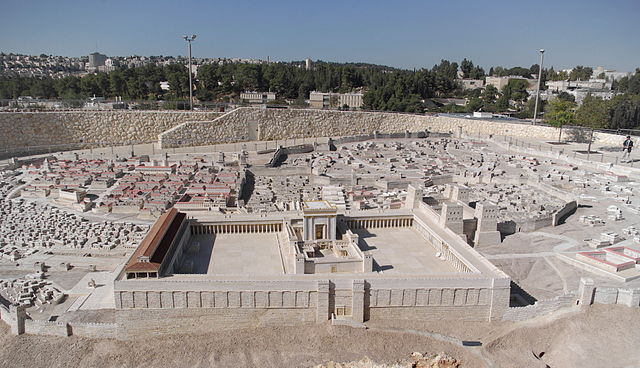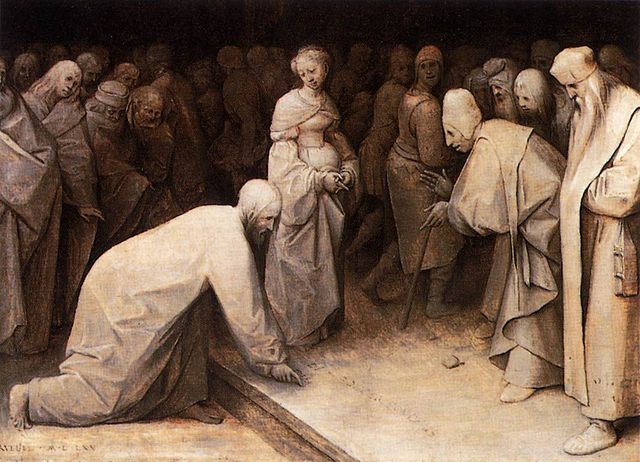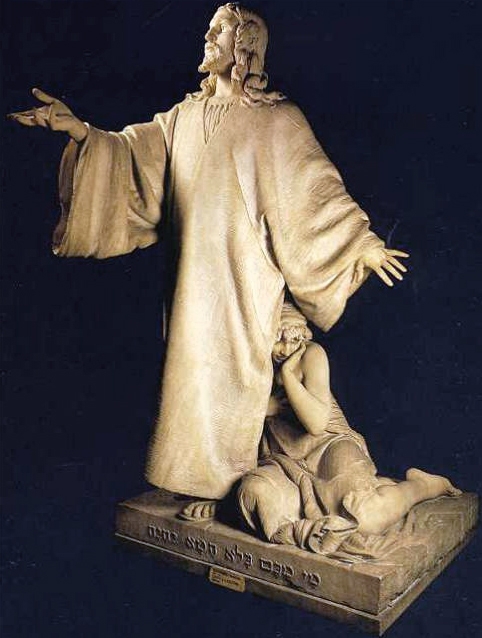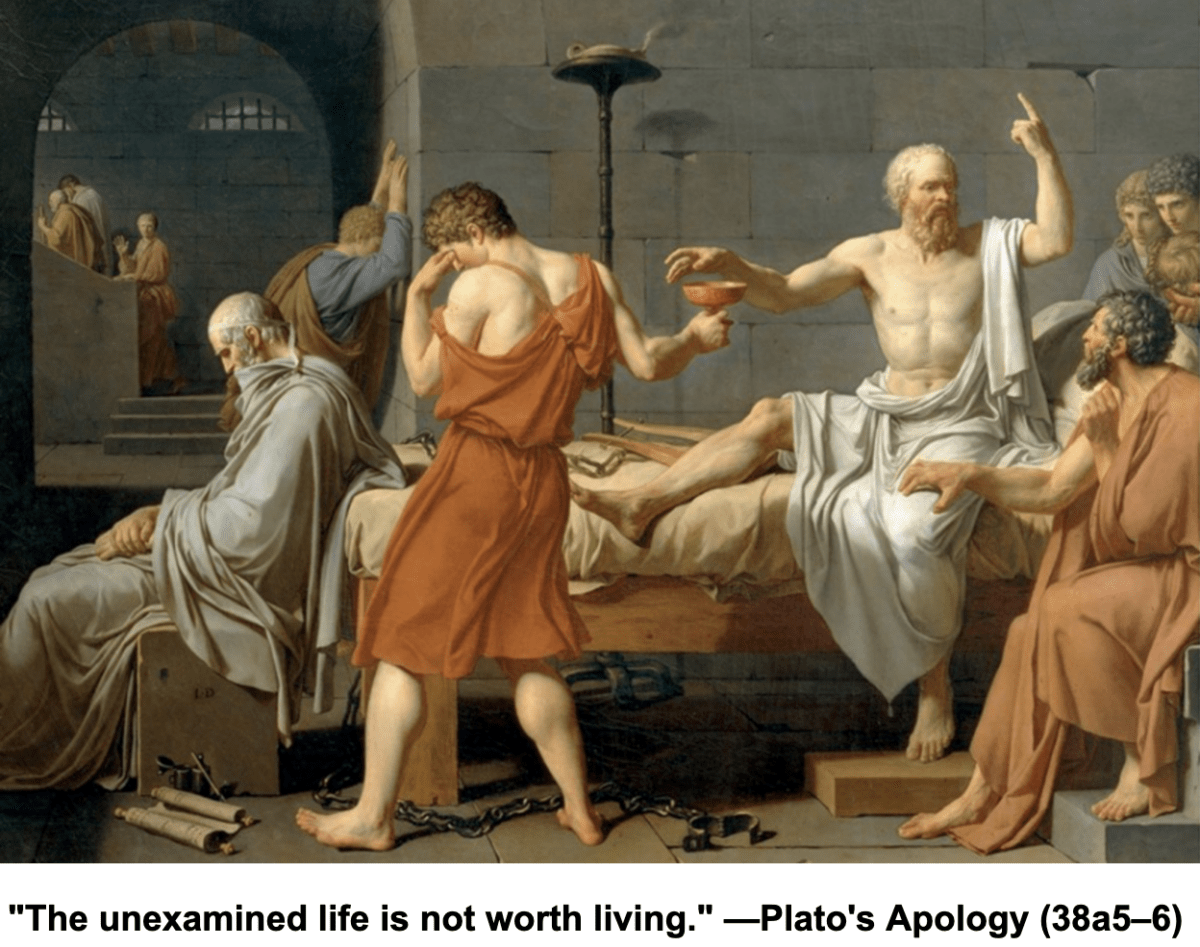The full meaning of an event chronicled in the scriptures will sometimes elude us if we are not acquainted with the historical, political, chronological, and geographical setting in which it unfolds. Such is the case with the story of “The Woman Taken in Adultery” found in the eighth chapter of John.
While in Jerusalem near the end of his ministry, Christ came early in the morning to the temple. Disciples and curiosity seekers soon gathered round to listen to expound on the scriptures. In the middle of his sermon Jesus was rudely interrupted by some scribes and Pharisees who came with a woman in tow. Depositing her at his feet they said: “Teacher, this woman was caught in adultery, in the very act. Now Moses, in the law, commanded us that such should be stoned. But what do You say?”[1]
John tells us that these intruders had come to test Christ, hoping to elicit a statement with which they could accuse and discredit him. We all know how this story ends, but at this juncture in the narrative we typically fail to ask, why are they doing this now? And why at the temple? And what could Christ be accused of by simply answering a question about how the Law of Moses should be applied in this instance?
To answer these questions we must first consider what transpired the day before, which was the last day of a seven-day celebration called the Feast of the Tabernacles. Jesus was in Jerusalem on that occasion, and as the feast reached its climax he stood and boldly proclaimed: “If anyone thirsts, let him come to Me and drink. He who believes in Me, as the Scripture has said, out of his heart will flow rivers of living water.”[2]
This obvious reference to Isaiah 55:1-3—where Jehovah invites “everyone who thirsts, [to] come to the waters … incline your ear, … and your soul shall live”—did not sit well with the chief priests. Christ, in not-so-subtle terms, was comparing himself to God. They were so incensed that they sought to have him arrested, but were deterred by Jesus’ popularity. They feared his seizure would incite the crowd. So that evening they conspired to trap him the following day.
Their strategy was to humiliate Jesus in public by posing a question regarding the application of the law that he could not answer without undermining his credibility and claimed authority. But to fully appreciate their machinations, we must look closely at the place where it was staged: the temple.

The temple area in Jerusalem at this time was about 35 acres, and most of it was open and clearly visible from the outside. At the top of three of the four surrounding walls were walkways, allowing Roman soldiers to patrol and monitor the entire area. Since Jewish uprisings often began here, Herod the Great constructed a large military fort on the north end—the Antonia Fortress, named for Mark Antony, his patron—so that the Roman legion could be summoned to swiftly respond to any sign of civil unrest.[3]
Picture, then, Christ teaching a large gathering on the temple grounds when he is suddenly interrupted by the Pharisees who present, not a hypothetical legal question, but an adulterous woman that they are delivering to the “Teacher” for judgment. They quote Moses, the great lawgiver, and then directly challenge Jesus to agree or disagree with the punishment prescribed for this offense: death. The tension must have been palpable since Jesus seemingly had only two choices.
He could have said, “By golly, fellas, you’re right; let’s stone her,” but that would have caused a great disturbance, if not an actual assault on the woman, resulting in his certain arrest by the Roman authorities. Or he could have pointed to the fact that Rome did not allow Jews to mete out capital punishment. And while he appreciated the desire of the Jewish people to live by their own laws, he must now counsel conformity and compliance. But such a response would have reeked of cowardice, discrediting the Savior in the eyes of his followers. For all present had one thing in common: a visceral disdain for the Romans.

Jesus chose neither alternative, opting instead for silence while stooping down to write something in the dust. By this simple act he communicated to his accusers that he was well versed in the law since that day was the Sabbath (ancient Jewish tradition dictated that the first day after every festival was a Sabbath). Since writing was considered work, it was prohibited on the Sabbath; but writing with one’s finger in the dirt was permissible because it was ephemeral; nothing permanent was created.
But what does he write? There is no clear answer and scholars have debated this question for centuries, but I am persuaded by the views of Kenneth Bailey, professor of Middle Eastern New Testament studies, who suggests that he wrote: “kill her,” or “stone her.”[4]
This may seem out of character, but it is the only correct answer to the narrow legal question presented: “What does the Law of Moses require?” He knew he could not speak aloud those words without inciting the crowd and inviting attention from the Roman soldiers; so by writing them in the dirt, they were only visible to his accusers and perhaps a few others.[5] And the words Christ then immediately spoke to the crowd—“He who is without sin among you, let him throw a stone at her first”—presuppose he had decreed the death penalty and that he wished to discourage anyone from repeating, or acting prematurely in response to, what he had written.
But why did his words succeed in deterring them? It’s because Jesus was not speaking to the crowd but to its individual members. By saying “He who is without sin,” he personalized the question, forcing each individual in attendance to accept responsibility for the choice he is about to make. He refuses to allow them to act collectively and thereby escape accountability. Surely, the verse from Isaiah, “All we like sheep have gone astray,” would have echoed in their minds, causing them to realize that to cast a stone would bring shame upon them and their families.
In a matter of minutes, Jesus has turned the table on his opponents. Everyone in the crowd is now looking at the chief priests and Pharisees to see what they will do next. Significantly, Christ again “stooped down and wrote on the ground,”[6] knowing that staring down his accusers would only compound their embarrassment. He refrains from twisting the knife. Finally, the elders elect to withdraw, experiencing the public humiliation they had intended for Christ; and everyone else follows. Jesus and the woman are all who remain, and he excuses her with the admonition that she go and sin no more.
We fail to realize the steep price Christ paid for his decision that day to shift the hostility of the chief priests away from the woman to himself. In a few months, he would return to Jerusalem for the last time where his enemies would be waiting—and this time they would pursue him with a vengeance. In reality, by not backing down, he did sign a death warrant that day in the temple. His own.

And who was this woman for whom Christ so freely gave his life? She was a stranger—he never learns her name. More importantly, it is unclear whether she acknowledged her transgression, repented, or expressed gratitude for what the Jesus had done. Nevertheless, the Savior’s act of mercy was given without condition or limitation. By this act, he foreshadowed the atonement and taught those with eyes to see that this woman was a proxy for each of us: recipients of a gift given with unconditional love that is ours to accept or decline.
[1] John 8:4-5 (NKJV).
[2] John 7:37, 38 (NKJV).
[3] Kenneth E. Bailey, Jesus Through Middle Eastern Eyes: Cultural Studies In The Gospels, (Downers Grove, Illinois: InterVarsity Press, 2003) p. 232-233.
[4] Ibid, p. 235.
[5] Before announcing their sentences, Roman judges would typically write them down, and the Greek term used here for writing is appropriate for that purpose. NKJV Cultural Backgrounds Study Bible, (Grand Rapids, Michigan: Zondervan, 2017), p. 1897.
[6] John 8:8 (NKJV).

Very very interesting and expanded look at a familiar Biblical story. Gives me a lot to think about. I do love the idea of assigning responsibility for action to individuals without the cover of the crowd.
Hi Eric: Great post! You might be interested in the CCP version of this story, covered in Bitter Winter. In the CCP version, “[t]he story in John 8 is presented to Chinese students as one where the Savior waits for the Pharisees to leave, then stones the adulterer himself.” The text is adjusted as follows: “The crowd wanted to stone the woman to death as per their law. But Jesus said, ‘Let the one who has never sinned throw the first stone.’ Hearing this, they slipped away one by one. When the crowd disappeared, Jesus stoned the sinner to death saying, ‘I too am a sinner. But if the law could only be executed by men without blemish, the law would be dead.’” Bitter Winter discusses the political context for the CCP version: “As told to Chinese students, the story teaches that the law and the Party are good and pure…. Even if the officers [of the Party] are corrupted, their decision should be accepted—because, honest or corrupted, they represent the Party, and the Party’s law should never be questioned.” It is interesting to consider that in adopting the KJV, we don’t often consider the political context that shaped its creation, and how this might impact the text or the lessons we draw from it. A tangent, I know, but your post reminded me of Bitter Winter. I’m glad you used NKJV! Steve
I liked that aspect of the story, too, Karen. What Christ did in this case was reminiscent of how Scout stopped the lynch mob in “To Kill a Mockingbird.” She converses politely with someone she recognizes in the mob—Mr. Cunningham—stirring his conscience and separating him from the group. And the rest begin to fade away in the darkness.
Steve, I absolutely love that! And it isn’t just that we don’t consider the political context of these stories; we also fail to consider how others—in this case, the CCP—can distort religious texts to advance their political objectives.
Thanks, by the way, for bringing Bitter Winter to my attention. They’re now on my “watch list.”